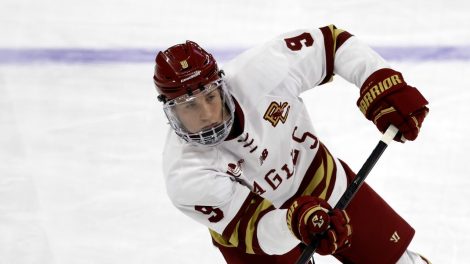Few expected Matthew Tkachuk to step into the NHL four months after being drafted sixth overall in 2016 and even fewer predicted he’d become a point per game player three years in. So as the 21-year-old wraps up a career year, how much of his production this season is due to luck vs. true growth in his game?
Plus: after back-to-back 32-goal seasons, why is Toronto’s Nazem Kadri struggling to even hit 30 this season?
Here’s this week’s Truth By Numbers column:
SPOTLIGHT PERFORMANCE
Drew Doughty really hates Matthew Tkachuk, saying this week he has no respect for the agitating forward. But I have to say despite Tkachuk’s antics he keeps surpassing expectations and for most people, that’s worthy of respect. Each season of his career Tkachuk has been better than anticipated.
As a rookie he forced his way not only into the NHL, but into the Flames’ top-six forward group. As a sophomore he nearly doubled his goal production in eight fewer games. This season he seems to have come out of his shell as a budding star, flirting with a point per game and nearly at his first 35-goal season.
Tkachuk saw a big jump in goals last season on the power play, finishing with 10 after getting just three as a rookie and his even strength goals jumped from 10 to 14. That’s good but not as pronounced as this season, where he’s kept that power play production at 11 goals, while his even strength goal production has risen to 23. That’s a massive increase.
The question then becomes whether or not Tkachuk has added something to his game that’s contributed to a shooting percentage jump from 12.8 per cent last season to 17.2 per cent this season. Last season’s shooting percentage was a solid, strong number for a top-six winger, but this year’s is quite high. We are living in a new era of the NHL where players such as Auston Matthews, Patrik Laine and Elias Pettersson can sustain high shooting percentages. Is Tkachuk one of those players, or have things just unfolded perfectly this season for a very good forward?

In terms of shot volume and quality, last season actually represented a better shooting season from Tkachuk than this one. He improved significantly over his rookie effort in all the important metrics and has shot a bit less often this season at even strength. However, there’s an added wrinkle here we have to put into context with Tkachuk’s playmaking, specifically his ability to get the puck to the slot for his teammates.
Over his first two NHL seasons Tkachuk was a very good playmaker at 5-on-5, significantly above the cutoff for a top-six forward. But this season he’s at a whole new level. His 1.8 successful slot passes per 20 minutes is tied for 16th in the league with Patrice Bergeron, Mark Stone and Sebastian Aho. That’s some good company.
Tkachuk’s passing off the rush has suffered a little bit this season after being one of the best in the league at it last year, but that’s not due to a change in style — he’s just had a lot of those passes blocked or fumbled.
When you look at slot pass attempts Tkachuk jumps up to 14th in the NHL and in raw totals he’s completed the 21st-most, which is in the same range as Mathew Barzal, John Tavares, Patrick Kane, and Aleksander Barkov. Those are all elite players.
So why am I talking about passing so much when the point was Tkachuk’s goal scoring? Well, last year he focused on improving his goal scoring and was successful, while this season he’s focused more on improving his playmaking and has succeeded at that as well. Having options when carrying the puck forces defenders to make a choice: play the shot or play the pass. It’s not very often that you’re in a position to do both at once, especially with a player who attacks off the rush as effectively as Tkachuk.
Pulling defenders out of shooting lanes to block off passes will give Tkachuk better shots, so it’s not surprising he’s turned better playmaking into improved goal scoring.
With that said, I doubt a shooting percentage above 17 per cent is sustainable over the long term, but I do think Tkachuk deserves a world of credit, maybe even respect, for mastering multiple styles of offensive production by the age of 21.
[snippet ID=3322139]
THE QUESTION
After being very nice for many weeks in a row and not talking about the Leafs, I figured it was time to let Steve Dangle ask a question about the Boston Bruins’ favourite playoff opponent.
Giddy with excitement over getting to talk about the Leafs for once, something Steve rarely gets to do, he asks…
“What’s going on with Nazem Kadri this season? After scoring 32 goals in each of the past two seasons, he’s struggling to get to 20 this season. What’s changed for him?”
The easy answer is that Kadri’s shooting percentage is in the tank this year. He’s scoring on just 9.2 per cent of his shots on goal compared to 14.3 per cent over the two previous seasons, but we can look into this a bit deeper.

Kadri has seen his goal production slip at both even strength and on the power play, but looking at his underlying shooting numbers over the past three seasons his shot measures at 5-on-5 have only improved. His shot volume is strong, his scoring chance numbers are better than either of the previous two seasons, but he’s scoring less. I’ll chalk that one up to puck luck.
The power play is a different story, though. Kadri is getting tons of chances, more than he ever has, but fewer are getting on net this season than either of the past two. After scoring 12 power play goals two seasons in a row, Kadri is on pace for just five this year despite strong scoring chance numbers. I think one of the main reasons why is because of how his role has changed on the Maple Leafs’ power play.
For most of the season he’s played in the same spot on the top unit as he did last season, but while his shooting position is the same, his role is a little different. Last season Tyler Bozak was in the spot Auston Matthews currently occupies, and his skating on the power play was basically a diagonal line between handling the puck and dishing it from the left side half wall, to skating towards the net to crash for rebounds.
Bozak was a simple but effective tool on that line, whereas Matthews is a bit more creative and tends to be less predictable. It’s a good things for the Leafs when goals come from Matthews’ area of the ice, but it means Kadri gets to take fewer risks.
Look at the drop in Kadri’s shots from the perimeter from last year to this year — he almost never leaves the slot on the power play. In an ideal world this is good. Shots from the slot are more dangerous, but a lack of movement also makes Kadri easier to account for and cover.
Another factor is that Kadri is a left hand shot, meaning if he wants a one-timer it’s going to have to come from his left. When Bozak had the puck in a shooting position he could easily change up without warning and send a pass to a waiting Kadri, but Matthews would have to pass across his own body to do the same shot fake. It’s easier to notice, takes a split second longer to pull off, and is therefore easier to thwart.
Top all this off with Kadri being among the league leaders in posts hit and you’ve got a player whose performance overall is the same, if not better, but whose goal production has been cut by nearly a third almost entirely due to circumstance.
BUY OR SELL
It’s close to the end of the year, so it’s awards speculation time. This season a bunch of them are already settled, so I think this space is a good time to go over them quickly:
• Nikita Kucherov is going to win the Hart. His 121 points are the most since Joe Thornton scored 125 in 2005-06 and Kucherov has five more games to potentially pad that number. He’s on pace for 129 if he plays all 82 games, which would be the most since Mario Lemieux and Jaromir Jagr recorded 161 and 149 in 1995-96. Kucherov was just about to turn three years old when those legends did that. Kucherov leads the league in completed slot passes at 5-on-5 with 135, is tied for 11th in scoring chances with 174, and he’s added another 128 completed slot passes on the power play. Blake Wheeler is the only other player above 100.
• Andrei Vasilevskiy is going to win the Vezina. He has the raw numbers and win totals to persuade the general managers who vote, but most impressively he’s hidden the fact that the Lightning aren’t actually very good defensively, especially when killing penalties. He’s faced the 10th-most high danger chances of any goaltender in the NHL, the 10th-most passes to the slot and 12th-most screened shots. He’s also posted the fourth-best high danger save percentage, the best save percentage from the slot, and second-best overall save percentage after Ben Bishop among starting goalies. Vasilevskiy’s been phenomenal.
• Elias Pettersson is going to win the Calder. This has been a slam-dunk all season. He’s still leading all rookies by more than 20 points despite missing a chunk of the season with injuries. The gap between Pettersson and the rest of the Canucks lineup was obvious, but the underrated part of his game is his ability to move the puck up the ice. Pettersson completed 20.5 transition plays per 20 minutes at 5-on-5 this season — the next-best Canucks forward was Jake Virtanen at 16.5, then Bo Horvat at 14. League average for forwards is about 16. This shows you how little the rest of the Canucks were moving the puck with control. Pettersson is a one-man team in that regard, and he had to be.
[relatedlinks]








